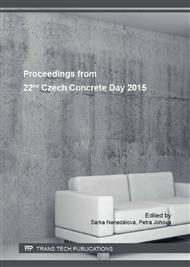p.136
p.142
p.147
p.155
p.160
p.166
p.173
p.179
p.185
Distribution of Stresses in Masonry Pillar with Fully Filled and Unfilled Perpend Joints
Abstract:
The paper summarizes the results of numerical analysis conducted with the aim to compare the distribution of stresses in masonry pillars constructed using different bricklaying techniques. The analysis was carried out in reaction to the discussion of members of Czech standardization committee TNK 37 – Masonry structures. Currently, most of masonry load-bearing structures in the Czech Republic are made from clay blocks without mortar in perpend joints. The analysis seeks the answer to the question whether it is possible, in case of the eccentrically loaded masonry pillars with unfilled perpend joints, to consider the value of design compressive strength calculated using the same approach as for pillars with filled perpend joints for the check of vertical load resistance. Supplementary comparison of the behavior of the pillars with filled and unfilled perpend joints loaded by lateral load in the plane of the pillar (corresponding to short shear walls) was also conducted. 2D FEM model created in ATENA Science software was exploited for the analysis. The results confirmed that the approaches contained in ČSN EN 1996-1-1 [1] are basically applicable for pillars with unfilled perpend joints.
Info:
Periodical:
Pages:
160-165
Citation:
Online since:
April 2016
Authors:
Keywords:
Price:
Сopyright:
© 2016 Trans Tech Publications Ltd. All Rights Reserved
Share:
Citation:


